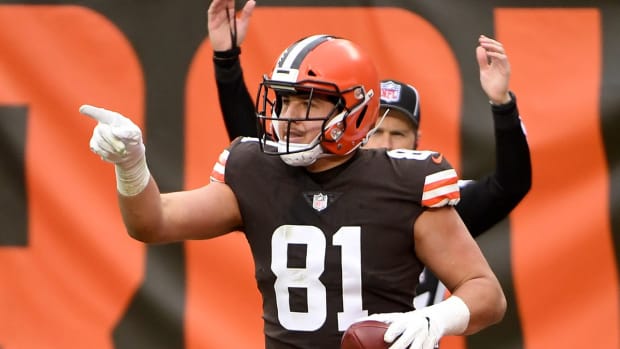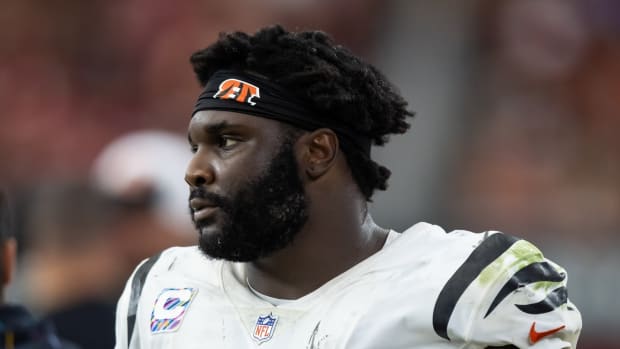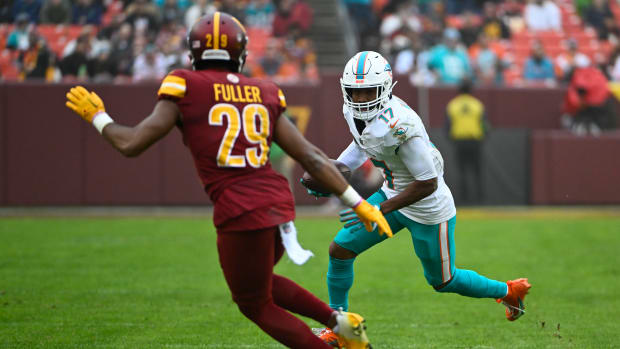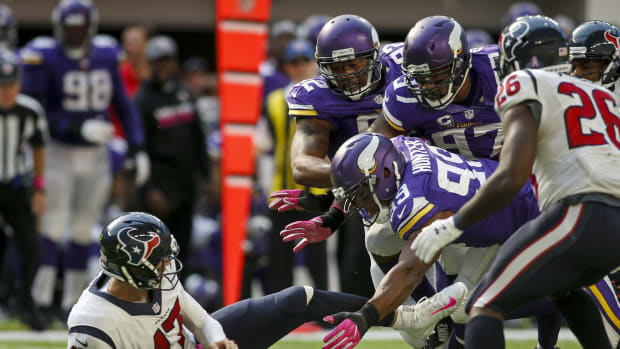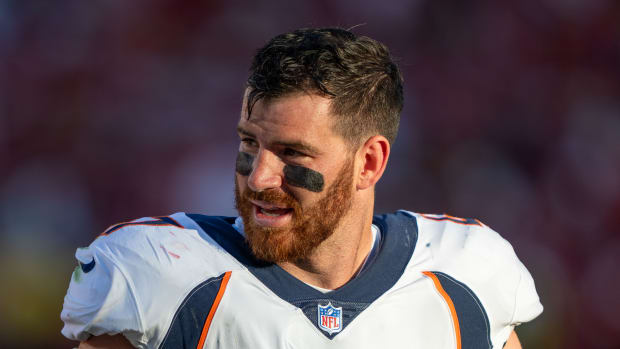The Key to the Patriots’ Latest Saga: Bill Belichick and Tom Brady Really Need to Talk
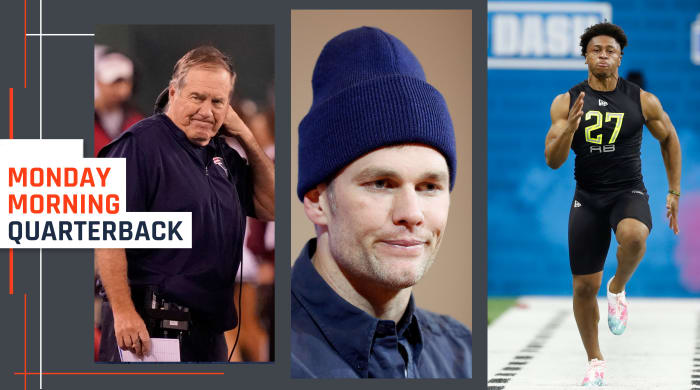
Robert Deutsch-USA TODAY Sports (Belichick); Winslow Townson-USA TODAY Sports (Brady); Brian Spurlock-USA TODAY Sports (Taylor)
INDIANAPOLIS – Tom Brady and Bill Belichick need to talk. For their own good. For the good of other quarterback-uncertain teams. And for the good of the rest of us, too.
Here at the NFL’s annual scouting combine, the convention center hallways, hotel lobbies, city skywalks and barroom corners were abuzz with a simple question: What is Tom Brady going to do? The 42-year-old’s impending free agency swallowed the week’s news cycle whole in a way we haven’t seen since Peyton Manning was in a slightly different spot eight years ago. And with good reason.
It’s not just that the greatest football player of alltime is available. It’s that the fate of the position in a handful of cities outside of the region he’s called home for 20 years are waiting on him too. Where Philip Rivers, Ryan Tannehill, Jameis Winston, Andy Dalton and Marcus Mariota land could be impacted with his decision. The balance of power in the AFC could shift as a result.
This is a big one. And it’ll likely come down to something comparatively simple: A coach and a quarterback sitting down and explaining to one another their positions.
Over the weekend, in talking to a number of people involved, the expectation is that the summit will happen. There were even some rumblings it was going to go down yesterday (though, as far as I can tell it hasn’t happened). Others expected it might be a little longer, thanks to the uncertainty on the CBA. Until it does happen, the resulting void will be filled with a lot of noise, some that has foundation, some that doesn’t.
And so I’ll tell you what I know.
My understanding is that Brady is open to returning to the Patriots, under certain terms. Likewise, I’ve heard Belichick is open to bringing him back, under certain terms. What’s left is for the two to sit down and see if one guy’s terms can match the other guy’s terms.
If that isn’t in the offing, I’d think both guys will recognize it and move on. If it is, I don’t think doing a contract and getting Brady back in the fold will be difficult.
So what we’ve all spent the last few weeks complicating isn’t really complicated at all. And until that simple discussion happens, it’s hard to be definitive, because I’m not sure Brady or Belichick themselves truly know what’s going to happen.
* * *
A long week at the combine in the books, and we’re back with this week’s MMQB. In here, you’ll find …
• Jonathan Taylor explains trying to race his way into Saquon Barkley’s class.
• Kliff Kingsbury on adjusting to the NFL.
• Combine nuggets.
• A CBA update.
Plus, a lot of good stuff in The All-32. But we’re starting with the story of the year, and where it goes from here.
* * *
If I had to guess right now, and this purely just my own feeling on it (I don’t know where Brady’s going), I’d set up the odds like this: Patriots 40%, Titans 40%, the field 20%. I’ve felt this way for a few weeks, so I’ll stick with those numbers.
Brady’s future can’t, and won’t, crystallize until he and his coach have that talk. There’s too much history, too much potential mutual benefit, and too heavy a legacy impact to be definitive on it until we get there. That said, there are facts out there that will color what happens when the sides do come together:
The CBA is a factor. Belichick’s not going to want a protracted negotiation over terms here. And whether or not a CBA is done would, necessarily, affect how a Brady contract is done, particularly because of the dead money (think of it as $13.5 million of credit card debt) he’d carry into it.
So part (a big part) of the wait here has been seeing if a new CBA gets ratified, in an effort to avoid needing a string of meetings because you agreed to things before having a full view of landscape. Belichick won’t want his time wasted—time that, in this case, would’ve been better spent getting a full read on quarterbacks that will be available, should Brady walk.
I’d assume Belichick and the Patriots got that read during combine week, which also allowed time for Brady’s agent, Don Yee, to survey the market. And that’ll make the discussion between Brady and Belichick, whenever it happens, far more informed.
The last negotiation is important, too. During those talks, a short-term extension was discussed and later scuttled. My understanding all along has been that years, not the raw financial total, has been the issue. Brady was hoping for a deal that would help ensure his place with the Patriots for a couple more seasons. That didn’t happen, which I think naturally raises his price tag.
That said, I don’t think the contract will be a big problem, if Belichick can hash out differences in other areas. But that’s one gigantic if right now.
The Krafts won’t intervene. Believe this: While this could set up, theoretically, as the one call that’s above Belichick’s pay grade, Robert Kraft isn’t going to play that game. And that isn’t because he’s taking anyone’s side. It’s for a very logical reason, actually.
Kraft knows that jumping in and making sure Brady retires a Patriot against Belichick’s wishes would likely be an enormously destructive move. If he does that, how is Belichick going to react? What would that do to the Brady/Belichick relationship, if Brady knew Belichick didn’t want him anymore and Belichick had Brady forced upon him? Worse, what would that do to the Kraft/Belichick dynamic?
The 77-year-old has been an NFL owner for 26 seasons. He’s seen those sorts of things happen in the past. And he’s too smart to make that kind of mistake here.
Brady will have suitors. The Chargers are planning to look into landing Brady. The Raiders are too. The Titans’ situation is a little more complicated—the idea of bringing Ryan Tannehill back in 2020 really does appeal to them, and they need to make a decision on tagging him before March 12—but they’re fully investigating the possibility to reuniting Brady with his buddy Mike Vrabel. Bucs coach Bruce Arians threw his hat in the ring, too.
The Giants and Colts aren’t among those suitors. You can cross them off the list. I was told pretty emphatically that neither will be in the mix if Brady does make it to free agency.
I’d be surprised if there’s a long, drawn-out free agent tour. The idea of a tour sounds nice. But those almost never happen with top-tier free agents in the NFL. The market moves too fast, which means no one, not the teams and not the players, has the time to let one play out.
Yes, Peyton Manning was an exception to the rule, but there were potholes along that road. Manning’s tour put the plans of five teams (the Broncos, Niners, Titans, Cardinals and Dolphins) on hold. The Titans missed out on a number of their free agent targets as a result. The Cardinals wound up worse (pushing pause on the position meant going into 2012 with Ryan Lindley and John Skelton—GM Rod Graves and coach Ken Whisenhunt were fired at season’s end).
If Brady does, say, a one-week tour, teams would be held hostage in a similar way. He is Tom Brady, and he waited 20 years to do this, so I do think he’s entitled to it. But what if, with all these other quarterbacks available (Philip Rivers, Jameis Winston, Marcus Mariota), a place he really likes gets trigger-happy and pulls out of the running? What if the team he signs with can’t be as aggressive with free agents and use the leverage having him gives them on the market early on, and that means he can’t maximize what’s around him? That’s not good for anyone.
On paper, the cleanest way to do this would be for Brady to make a decision on the Patriots before or during the March 16–18 tampering window and, should he decide to leave, sign with someone not long after the start of the League Year (4 p.m. ET on March 18).
Agreeing with the Patriots before March 16 might be complicated. Part of Brady’s frustration last year stemmed from what was around him, and it’ll be tough for New England to truly prove its intentions to upgrade that before Brady has a chance to kick the tires on his options outside of Foxboro. And at that point, other quarterback options will be coming off the table, which will force New England to decide whether to walk away from the face of the franchise or risk being screwed at the most important position on the field.
There are two decent examples in the recent past to describe how Belichick thinks through these situations. In 2013, Wes Welker fielded offers from the Broncos and Titans early in free agency. Then, he tried to circle back to see what the Patriots could do. But by then, the team had lined up Danny Amendola to replace him. Conversely, last year, the Patriots were less aggressive waiting for Rob Gronkowski, and lost a shot at Jared Cook as a result. My guess is, Belichick will see being OK at quarterback as much too important to risk waiting.
Brady leaving would be complicated too. Inside the Patriots’ quarterbacks room, Brady has, in the past, wondered aloud about other teams’ offenses in a less-than-complimentary way, seeing a lack of complexity and detail in what’s happening across the NFL vs. the way it’s done in New England. Why is that relevant? Because I believe it’ll be borderline impossible to recreate what he has in Foxboro.
There, he has a head coach and an offensive coordinator he goes back two decades with, and a system that is truly his—bastardized (in a good way) over the years specifically to what he does well and what he doesn’t do well. And while I’m sure anyone courting him will try to find a way to install elements of the scheme he’s run in New England, I have serious doubts that another team could come close to duplicating it.
Off-field factors won’t be irrelevant. Of course, there’s Brady’s TB12 business. There’s also his family. If his kids are in school in New York , and with his first son rooted there, I’d assume it’d be preferable for Brady to be in a place that’s not too far away. Foxboro’s a reasonable enough commute to where he could get there during the season. Nashville’s not far on a private jet. Los Angeles and Las Vegas would be more difficult. Do I think this will be a driving factor? I don’t know for sure. But I don’t think it’ll be an afterthought.
* * *
And then, there’s a less tangible piece of all this.
For 20 years, Brady’s enabled Belichick’s program. Because he’s been so good, the team’s margin for error has been sizable—they could strike out on a first-round running back or a free-agent lineman, or even bring a little less to the table on defense, and Brady would routinely make up for it. Moreover, because he’s been willing to take tough, unrelenting coaching, he’s made it so Belichick rarely has to ask any player twice to do anything.
Tom Brady’s over there doing it, so you better do it too.
Simply put, his value to the team has been immense. That explains why, when denied the extra years last summer, and told that the team had to be careful because he was heading into “uncharted territory,” he would be miffed. Almost anyone, in Brady’s spot, would look at it in like, After all I’ve done for you?
Which is where, I think, respect comes in, and respect can be shown in a lot of different ways. Respect can be shown in a team operating with an urgency to win now, it can be shown in money and years on a contract, and it can shown in supporting a player’s off-field interests in the twilight of his career. Accordingly, I think respect will a factor here.
And showing respect should start with Belichick sitting down with Brady, one-on-one, and giving his quarterback the forum to explain what it’ll take for him to stay in New England.
* * *
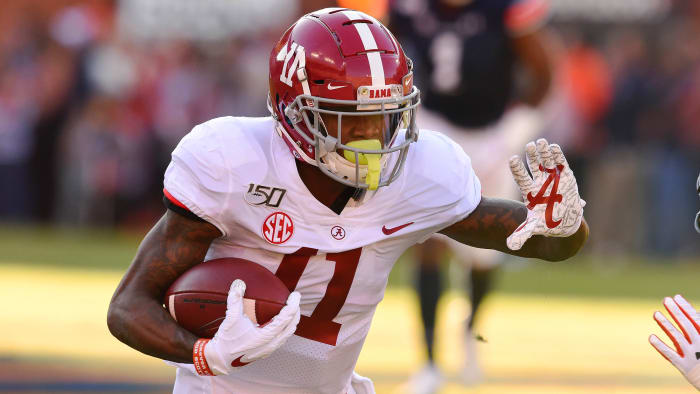
Ruggs, who ran a blazing 4.27 in Indy, averaged 18.6 yards on his 40 catches last season for the Tide.
John David Mercer-USA TODAY Sports
COMBINE TAKEAWAYS
To wrap up the combine—and we had some big winners in Indy (Alabama WR Henry Ruggs, Wisconsin RB Jonathan Taylor, Clemson LB Isaiah Simmons, Iowa OT Tristan Wirfs, Louisville OT Mekhi Becton)—I wanted to give you a good look at how the guys in the building with the stopwatches around their necks saw the week.
So I sent out a bunch of texts asking for guys’ biggest takeaways from Indy, be it from the field at Lucas Oil Stadium or elsewhere. Here’s what I got back.
AFC exec: “To me one story coming out is the athleticism and depth of tackles. You got top tier guys like Wirfs, [Jedrick] Wills, Becton, [Andrew] Thomas. Then [Ezra] Cleveland, and another tier of size and athletic ability. Some of these tackles are ready to go now, and play at a high level. Overall, best tackle class in quite a while in my opinion.”
NFC exec: “The thing that jumped out is the depth at WR. There’s more depth at OL than I thought, and corner depth may be 3–4 rounds deep. Schedule was strange and need to look at difference in results compared to years past to understand, not a lot of free agent news [because] everyone was waiting on CBA info and very few projected numbers thrown around.”
AFC GM: “The [inside linebacker] group has some speed in it. [Justin] Herbert looked good, [Jake] Fromm not so much. The RB group looked slow.”
NFC exec: LBs were fast, also DTs. Obviously, the OTs showed out. I didn’t meet too much on [free agents] due to the new schedule, heard some big numbers though.”
AFC exec: “Impressive tackle class—the size and athleticism of some these guys were off the charts. WR class was as advertised. Corners ran slower than expected. Haven’t seen all the official times yet, but the first times weren’t good for some guys.”
AFC GM: “My biggest takeaway is a lot of agents are shooting for the moon on average players. I think some are gonna be surprised at what their market truly is.”
AFC exec: “Edge class isn’t very deep, but interior pass rushers are more important and it’s a good class. More obvious, but it’s a rare free agent period, since it’s a starter market. Backups are trying to get signed ahead of it. Wide receiver is historically deep. Should be able to get a starter in round 3.”
NFC exec: “Good corner class. Lots of big guys that ran fast. Think almost 20 guys 4.49 or faster.”
AFC scouting director: “One thing that stands out is hearing some teams’ cap situations affecting their ability to keep some of their FA players.”
NFC scout: “Herbert looked good. Not much of an opinion on the other QBs that threw though. [Justin] Jefferson impresses me a lot. I think he’s a first-rounder, and going to be really good. Taylor had a great week and I think it’s not crazy to think he goes round 1. I didn’t think he got enough credit all year and people slept on his speed. Dobbins will have work cut out for him to pass him. And the top of the tackle group is ridiculous. Can see them all going top 15. The interior DL were much better than the edge players. The edge group was about the most unimpressive group I’ve seen since I’ve been going. LBs could all run. Really fast group and it’s good to see that because they have to do it. Safeties ran well too and i think there’s some good depth there.”
We should have more coming in the afternoon column. And speaking of combine winners.…
***
THE NEXT SAQUON?
Forget the 40, what Jonathan Taylor was really concerned about going into Indy was his interviews with teams. And so it was that his favorite memory came from inside one of the suites at Lucas Oil Stadium, where the interviews were held.
The Wisconsin running back was ready for off-the-wall questions. He got none.
“It's crazy because a lot of the questions I got were really just background questions, and questions about football knowledge,” Taylor told me on Saturday night, after getting back to Arizona, where he’s training. “And I asked a coach about that, I said, ‘A lot of people speak about the interview process being crazy, and questions that’ll make you scratch your head.’
“The coach really just said, ‘Yeah those are for the kids with character issues and people who we really don’t know. We don’t have a good idea of who they are and we’re trying to figure out how they respond and how they react.’ They did say that the running backs were a good group and that there weren’t too many questions being asked.”
So Taylor answered all the questions in that setting the right way, before more than answering every question during his athletic testing on the field. In fact, if you drill down on the numbers, you’ll see that the Badgers junior profiles similar to another Big Ten back of recent vintage, the one who went second overall two years ago: Saquon Barkley.
Taylor: 5’10”, 226 pounds; 4.39 40; 17 bench reps; 36.0 vertical; 4.24 short shuttle.
Barkley: 6’, 233 pounds; 4.40 40; 29 bench reps; 41.0 vertical; 4.24 short shuttle.
And if you compare their on-field production in three college seasons—Barkley rushed for 3,843 career yards and 43 touchdowns on a 5.7-yard average, Taylor went for 6,174 yards and 50 touchdowns on a 6.7-yard average—Taylor far outpaces his Penn State counterpart.
Yet, for one reason or another, Taylor hasn’t been seen in quite the same light as the super elite backs that have come out of college the last few years, guys like Barkley, Zeke Elliott and Todd Gurley. Instead, he came into this combine battling Georgia’s D’Andre Swift and Ohio State’s J.K. Dobbins for pole position among the tailbacks. And what he did with his eye-opening 40 was affirm that he took all of that as a challenge.
“You’re off of football for about three months and everyone knows you're basically interviewing for the next level,” Taylor said. “Everyone really wants to see, What’s the work you've been putting in? They had their guesses and their opinions—it’s just like a football game. Everyone has their guesses and opinions of who's going to win, everyone has their guesses and opinions of how certain people are going to do at the combine.
“So, of course, if someone does well, there’s going to be a lot of buzz around it.”
And Taylor got that buzz. But he’s been building towards breaking old stereotypes of big Wisconsin backs—that they’re plodders, which is one reason why Taylor thinks this wasn’t expected of him coming in.
It really started with his college coach, Paul Chryst, selling him on the idea before his junior year that the Badgers would turn 50 of his carries into catches. They didn’t get there, but Taylor wound up with 26 receptions for 252 yards (more in both categories than his two-year total coming into his final season), and that both opened up the offense, made Taylor better in space and, naturally, set up him for the pros.
And after the season, he took that approach to training for the 40. Because he has a track background, Taylor has a natural glide as he runs, which can work to fool people into thinking he’s not moving that fast. But he knew all along he was. While he didn’t run the 40 much as a Badger, he’d clocked in the mid-4.4s a couple times and was around there in January, when he started pre-draft training at EXOS in Arizona.
Two weeks ago, he clocked a 4.37, which prompted his goal to get into the 4.3s at the combine. On his first run, the broadcast showed an unofficial time of 4.41. And eventually, the official time posted: 4.39, topping what Barkley did three years ago.
Does that mean he’s as good as Barkley? It doesn’t. But he sees himself in that class.
“Todd Gurley was a playmaker on the field, Zeke was a playmaker on the field, Saquon was a playmaker on the field,” Taylor said. “Same thing with myself: playmaker on the field. I’ve been constantly able to make plays for three years, and that’s something I really wanted coming into college. I wanted to make sure for the three years I was here, that I was consistent, coaches knew what they were getting out of me every single practice, game, rep.
“They knew that Jonathan Taylor was going to play at a high level and that he was doing it consistently. Same thing with Saquon Barkley and Ezekiel Elliot, I'm sure their coaches knew every single day, that player was going to play at a high level.”
As for what he hopes coaches take from it, Taylor said he wants NFL teams to view his performance as a window into his preparation, since there’s no question he was ready for the moment here.
* * *
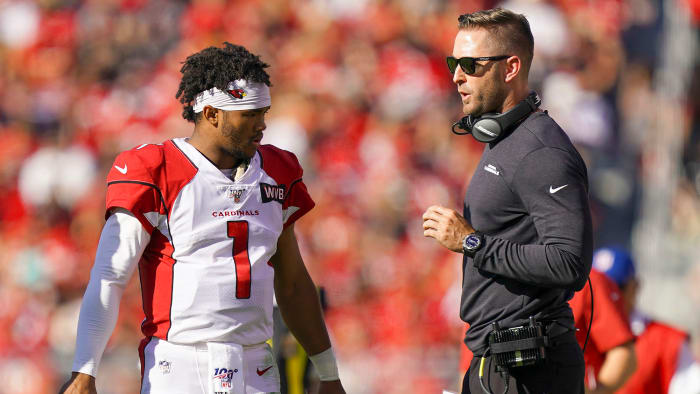
Under Kingsbury, Murray threw for 3,722 yards as a rookie for the Cardinals.
Kyle Terada-USA TODAY Sports
KATCHING UP WITH KLIFF
I had a blast working with Cardinals coach Kliff Kingsbury on this story last week—about where the NFL missed with Patrick Mahomes. But that wasn’t the only subject we touched on, so I figured I’d roll out a few other things from our meeting in Indy. Here goes.…
MMQB: Biggest adjustment you had to make, or biggest difference you noticed, coming to the pros?
KK: Two biggest things that jump out. [First,] consistency day-in, day-out. It’s a long season, you’re gonna have some down moments. There are games where the best team has one of those games and they lose by 25 points, like, ‘How did that happen?’ It’s such a long season, you gotta be consistent in your approach, and those guys respond to it. And the second thing is situational football, because each game is so close. Really getting you team dialed in on that is a big deal.
MMQB: So the scheme translates right over?
KK: Yeah, it does. You see different styles of defense, styles you might not see as much. There’s a lot more man, there’s not the free access throws that you get in college. For the most part, the scheme translates. We had to do some things to adapt out personnel. And there aren’t as many wasted in plays. In the Big 12, you get 80, 90 plays. You’re getting 50–60 here. So every play counts. You can’t have a bad playcall.
MMQB: Is Kyler Murray where you thought he’d be?
Yeah, he is. He’s just figuring it out, he’s never been a fulltime quarterback in his life. So I think he’s figuring that out, being the face of the franchise. But his skill set, competitive nature, even the information he can gather and give back to you on the field—it’s top notch.
MMQB: So since he’s got all that time now, not playing baseball, have you guys worked on a plan for what he’ll do leading up to the offseason program.
KK: We’ve talked through it, the expectation, where we want to take this thing. I’m excited because of that, because he’s never had an offseason where it’s just been film study, it’s just been preparation, footwork, throwing. I think he can really take a big jump.
MMQB: Have you gotten to think how, with the spread offense and shorter quarterbacks, you guys have been on the front end in breaking down some barriers?
KK: Yeah. I think more than anything, I’m excited for those players having an opportunity, because I think people are starting to wrap their minds around different ways of approaching the NFL. That’s what’s exciting. To see Kyler have an opportunity, to see a guy like Pat playing at the level he’s playing at, that makes it fun for me.
* * *
WHERE WE STAND ON THE CBA
This week will be another critical one as the NFL and NFLPA try to hammer out a new collective bargaining agreement. As those involved wake up this morning, eight or nine days away from the NFLPA electing a new president, and 16 days from the start of the 2020 League Year, lawyers from both sides are continuing to chip away at the language of the 300-page document.
There’s not a timetable on its completion, but when that happens, it’ll be sent to the league’s 2,000 (or so) players, who will then get a few days to review the document before voting on it. A simple majority is needed to ratify it. So that’s what everyone’s waiting for now.
Want some more on where we are?
• Last Tuesday was a long day for the players. The NFLPA’s executive committee and a select number of player reps met for four hours with the league in the early evening in downtown Indy, with the remainder of the player reps (all 32 teams were represented) holed up in a hotel suburban Carmel. Then, those downtown retreated to the suburbs, where the larger group of players met for five hours. The result of that was the 17-14-1 vote in favor of the CBA by the player reps. That vote was taken at 1:15 a.m.
• The league made a couple minor concessions during the meeting downtown to sweeten the pot for the players. They agreed to remove the $250,000 cap on the extra game check, in the event the league adds a 17th game, and added tweaks to the work rules to further lighten the players’ offseason load.
• The NFL also agreed to a plan to form a committee made of union leaders ahead of the league adding 17th game, and that committee would engage with management in researching the effects of adding to an already arduous schedule, with the idea being that all concerns would be addressed before the change is made.
• The election of a new union president should not be ignored. Typically, that is done on the final day of the rep meeting, so it’ll happen either next Wednesday or Thursday. Chargers OT Russell Okung is the only player to have publicly declared his candidacy thus far, and he’s be an ardent critic of the deal. So if there are any hiccups over the next 10 days, and uncertainty remains post-election, the dynamic within the union ranks could change.
So how does this go? Two things make me think the CBA will pass when the union actually votes. First, some 60% of the union ranks are on the minimum, and those guys benefit most from the deal: It’ll mean an immediate $100,000 raise for each of them. So I’d think the great majority of those guys will probably vote for it. Second, we haven’t seen the normal explosion of criticism from agents, which could be read as tacit support of the deal.
Either way, it won’t be too long until we know.
* * *
THE ALL-32
The 49ers’ impending negotiation with George Kittle figures to be a little complicated, just because tight ends aren’t paid like other skill spots. The highest-paid guy at the position (Jimmy Graham) makes $10 million per, and he might get cut. There are only two others making even $9 million per (Travis Kelce, Kyle Rudolph). For context, making $10 million per would make you the NFL’s 22nd-highest-paid receiver, and making $9 million per would tie you for 25th. Maybe Kittle can blow up the paradigm here. But to do it, you’d think he’d have to play out the final year of his deal, because generally if a team’s willing to go a year early, they’re looking to get a little back. That might be why Kittle’s agent said he’s ready to be “very patient” with the negotiation.
Speaking of tight ends, I’m not saying Bears won’t go forward without supplementing at the position, but word is they’re OK with Trey Burton being the headliner there, on the belief that he’s just had a lot of bad injury luck the last couple years.
One relationship the Bengals can pull on with Joe Burrow: Third-year defensive end Sam Hubbard was actually roommates with Burrow at Ohio State. My understanding is they’ve tapped into that resource, enabling the team to get a feel for where Burrow is on coming to Cincinnati. Additionally, I’ve heard that Burrow has actually asked other teams about their impressions of the Bengals, so he’s doing his homework too.
For what it’s worth, the Bills spent a considerable time with the top receivers in the class at Indy—including Alabama’s Jerry Jeudy and Oklahoma’s CeeDee Lamb. Those sorts of things aren’t always a tell, but Buffalo could use a No. 1 to pair with complementary weapons Cole Beasley and John Brown. And they’re picking at 22, right around where there could be a run on them.
Easing the Broncos’ decision to tag Justin Simmons? The safety figure will be reasonable—it’ll probably come in under $12.5 million—which will make doing a long-term deal with a player Vic Fangio loves easier, in an environment where four safeties (Kevin Byard, Tyrann Mathieu, Landon Collins) got around $14 million per last offseason. Another interesting twist to this: Simmons’ old agent from CAA, Rich Hurtado, is now Denver’s lead negotiator.
If I’m the Browns, I approach Myles Garrett about an extension now. And I know that sounds crazy. But he’s going to be very expensive. Doing it now, while he’s coming off a suspension, would constitute buying low on a star, and this may be the spot where he’s inclined to take a little less to secure his financial future.
I’d be very surprised if the Buccaneers don’t tag LB Shaq Barrett. I also think they’d be comfortable going forward with him playing on his one-year tender, given the one-year explosion in his production.
I think the Cardinals’ decision to give tackle DJ Humphries a three-year, $45 million deal will look wise once we get through free agency, given what guys like Jack Conklin, Joe Thuney and Graham Glasgow should pull in on the market.
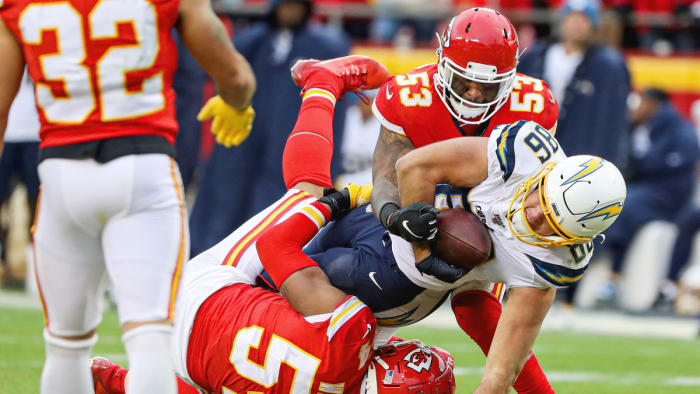
Henry has been productive, but he’s missed 23 games in his four seasons with the Chargers.
Jay Biggerstaff-USA TODAY Sports
Why would the Chargers use the franchise tag on TE Hunter Henry? Given his injury history, there’s risk there. But the tag is very affordable; it should land right at $11 million. Tagging Henry would buy GM Tom Telesco and coach Anthony Lynn time to make a long-term decision on the fifth-year tight end, and ensure that the weaponry on hand would be as attractive as possible for a veteran quarterback that might consider coming. And I can say that right now they are considering the possibility.
Could the Chiefs tag and trade DT Chris Jones? I don’t think it happens. But I’m also not ruling it out. When KC signed Frank Clark, who’d arrived via trade, to a deal worth $21 million per last year, they effectively set the floor for Jones. And they’ll have him on the tag at around $16 million, meaning they might be hesitant to extend that far. This contract won’t be easy to do.
We’ve drawn you in recent weeks to the connection between Colts coach Frank Reich and offensive coordinator Nick Sirriani, and free agent quarterback Philip Rivers—Reich and Sirriani, along with Mike McCoy and Ken Whisenhunt, formed a sort of quarterbacking think tank around the star years ago in San Diego. But there’s a connection to another quarterback here that shouldn’t be overlooked as Indy examines its options. Colts tight ends coach Jason Michael is very close to Marcus Mariota, having worked with his closely for four years in Nashville. Which makes Mariota another option here.
The Cowboys’ deliberate negotiation with Dak Prescott will have two pieces of impact, if an extension isn’t done in the next 10 days and the team is forced to tag its quarterback. One, it will force the team to budget nearly half its cap space for a lump-sum salary for the quarterback. Two, it would mean that, if a CBA is ratified, there’d be nothing stopping from receiver Amari Cooper getting to unfettered, unrestricted free agency. The clock is ticking.
One thing teams kept coming back to with me this week regarding the Dolphins was the presence of owner Steve Ross at the Alabama/LSU game this fall, and again at the Tide’s bowl game against Michigan in Tampa. (Michigan is Ross’ alma mater, but still.…). Clearly, Ross took an interest in Tua Tagovailoa. On the flip side, he publicly expressed concern with Tagovailoa’s injury history. So his meetings with the Miami doctors are key.
I’m not sure the Eagles have a set-in-stone decision made on Jason Peters yet—and I know there is split opinion in the building, on whether to keep Peters for one more year or go with second-year left tackle Andre Dillard and use the money saved to further bolster the line. We know the importance GM Howie Roseman puts on the line of scrimmage, so it’s not hard to see how he, and the organization, would view this decision as critical.
After combine week, I don’t know if the Falcons should feel any more confident about their chances of keeping free agent TE Austin Hooper or LB De’Vondre Campbell. I know they’d like to have those guys back. But with the team’s cap situation where it is, that would have to be at something of discount, which would require the market dropping out on one or the other.
The Giants’ hiring of former New England assistant Patrick Graham as defensive coordinator should send fans to the internet to start studying one particular draft prospect Clemson LB Isaiah Simmons. Simmons’ versatility—he can play on all three levels of a defense—looks like it was drawn up with a Patriots-styled scheme in mind.
I’d look for the Jaguars to take a serious swing at upgrading the tight end position. This being a light year in the draft, they may have to do it in free agency—which would be challenging, given their cap situation.
And the Jets will be every bit as serious about fixing their long-shaky offensive line. I wouldn’t be shocked if they sign multiple high-end linemen in free agency. That might’ve become even more of a likelihood after last week, during which the top four tackles in the draft (Mekhi Becton, Tristan Wirfs, Jedrick Wills, Andrew Thomas) helped themselves—and hurt Jets GM Joe Douglas’ chance of getting the one he wants with the 11th pick.
We mentioned Lions G/C Graham Glasgow as a candidate to get more than people think. Right now, it looks like his price tag is going to come in at over $10 million per. Which means Detroit will probably be looking for a new starter at guard.
Aggressive as Packers GM Brian Gutekunst has been early in his time in charge, it’ll be interesting to see what he does at inside linebacker and tight end in the veteran market. Green Bay has a free agent (Blake Martinez) and cut candidate (Jimmy Graham) at those spots, and will have options to swap them out, with guys like Nick Kwaitkoski and Hooper on the market.
Thought this was a telling quote on who new Panthers coach Matt Rhule is, from Baylor DE James Lynch’s media session this week (via the Charlotte Observer): “Yeah, so the first time he came to my house, like when he recruited me for Baylor, he told me, ‘I want to be an NFL head coach.’ And then obviously at the time that didn’t mean as much to me. But by about our second or third year, my last year, you could tell he was ready for it.” So much of being a good head coach in the NFL is about connecting with people, and getting them to trust you. Rhule seems to be pretty good in that area.
The Patriots indicated this week as they met with agents that their hat will be in the ring with free agent tight ends. They inquired on Hooper before the trade deadline, but it may be tough for them to get to what he will command on the market. If Henry’s tagged, as expected, it’ll be challenging to find a paradigm-shifting answer at the position. But New England’s always been creative about these things. I’d expect they will be in trying to find the guy to fill Gronk’s old spot.
Assuming the Raiders don’t land Tom Brady, I wouldn’t rule out the idea that the team brings in a veteran to push Derek Carr, rather than just replace him from Day 1, a la Ryan Tannehill in Tennessee last year. Maybe that’s someone like Jameis Winston.
Part of Sean McVay’s revamping of his Rams staff was creating a renewed sense of urgency around the building. And it sure seems like it’s working. To those around McVay, going 9–7 last year felt like going 4–12. Which is a pretty good sign for how much higher the bar has been set in LA, as opposed to where the franchise was over the last decade.
Much of the concern over where the Ravens go this offseason has been centered on high-profile defensive free agents Matt Judon and Jimmy Smith. But there might be a hole to fill on offense too. I don’t think it’s a sure thing that seven-time All-Pro guard Marshal Yanda returns for a 14th NFL season. And if he retires, he’d leave big shoes to fill.
The Redskins are doing exactly what they should do in kicking the tires on the draft class’ quarterbacks. One, they need to know what they’ll be passing up if they do go chalk and take Chase Young with the second pick. Two, it should work to light a fire under Dwayne Haskins. Three, it would effectively draw out teams interested in trading up for a quarterback; those clubs can’t start talking to the Lions at 3 until they’re sure the Redskins aren’t moving the second pick.
The challenge for the Saints this offseason will be developing under-the-radar talents to replace the ones they’ve developed to the point where they’ll be too costly to keep, like DT David Onyemata and S Vonn Bell. New Orleans knows it can’t pay everyone, and so it’ll have to be selective in who it rewards as its string of home-run draft classes start to become eligible for new deals.
The amount of tags coming for edge-rushing free agents might put the Seahawks in a difficult spot with Jadeveon Clowney, who stands to cash in with so many of his counterparts being taken off the market.
And one of those guys that’ll probably come off the market is Steelers outside linebacker Bud Dupree. The team is likely to tag the former first-round pick, after the 27-year-old broke out with 11.5 sacks in 2019.
Texans left tackle Laremy Tunsil may want to wait a couple weeks before pushing his extension over the goal line. My feeling is that free-agent tackle Jack Conklin and guard Joe Thuney could land in the $15 million-per range, and that would bolster the argument that Tunsil is worthy of becoming the league’s first $20 million offensive lineman.
If the Titans lose Conklin, what they do with free agent Dennis Kelly will be interesting. Tennessee traded for him as an insurance policy a couple years back, and he’s been good when given the chance in backing up both tackle spots. Kelly turned 30 in January.
The Vikings’ cap gymnastics have begun, and the spot to watch going forward is still cornerback. Xavier Rhodes is probably gone, and Trae Waynes is a free agent. With limited money to spend, it seems the likelihood that their first-round pick will be a corner is almost as good a bet as that last year’s would be an offensive lineman.
* * *
TOP FIVE
Defensive tackles will get big money. And that’s even though you might not know the names of the guys who are atop free agent lists right now. Pittsburgh’s Javon Hargrave figures to make the biggest splash, and could top $12 million per. Houston’s DJ Reader and New Orleans’ David Onyemata and Houston’s DJ Reader should each top $10 million. And Cincinnati’s Andrew Billings might not be far off from that either. In each of these cases, teams see players who were somewhat limited role-wise by either the scheme they played in and/or the teammates they were splitting time with. Which is to say each of the aforementioned four have a lot of room to grow.
Tony Romo’s deal at CBA frames where the TV money is right now. And why the owners see now being the time to work with the networks on extending the league’s broadcast deals. Romo was a target of Disney as it tried to get ABC/ESPN into the Super Bowl rotation and show readiness for Monday Night Football to go to ABC (though I’m sure some at Disney want to keep MNF on ESPN, because of what it means, cable subscriber-wise). That underscores how competitive the bidding will be between all the networks, and how the NFL is in a sweet spot, given where the economy, the market and ratings are. Keep in mind that the election could affect all of that.
Football-side people are feeling the pinch, again. As was the case during the last CBA neogtiations, coaches are looking at concessions the league is making to the union and seeing, once again, where their work has been an afterthought. Cutting the number of padded practices in training camp from 28 to 16 is one example. And if you listened close enough this week, you’d hear similar issues raised over how the combine was run, with coaches having an enormous amount of downtime in their days, and interviews scattered across all hours at the stadium, rather than being held consecutively and closer to the hotels, all to accommodate the broadcast’s move to primetime. All this stuff is valid, too, for guys just trying to do their jobs. But … I think complaints are going to fall on deaf ears. The ratings more than doubled, and giving players more time off is helping broker another decade of labor peace, so my feeling is the bosses are going to tell the guys working for them to just deal with it.
And the league could pay a price for this eventually, too. The Rams and Broncos kept a lot of coaches home last week, and lots of coaches and scouts forecasted more teams following suit next year if the schedule is unchanged. Meanwhile, rumblings persisted that the top players should seek payment for competing in Indy, given how the league has monetized it around their talents. And agents worried how running at that point in the day could increase the risk of injury—on Saturday night, potential first-round linebackers Patrick Queen and Kenneth Murray tweaked hamstrings running the 40. Add all of this up, and if you have fewer coaches attending what’s become the NFL’s version of a trade show, and fewer players participating, it’ll take away some of what’s made combine week what it is. Does that mean the league shouldn’t try to monetize it? Of course not. I just think it’d be smart to tread carefully. Because if the event loses its meaning to players and teams, what they’re trying to monetize will become less valuable.
Replay reaches a critical stage. My old NFL Network colleague Judy Battista reported last week that a competition committee survey showed that teams are overwhelmingly against permanently instituting the pass interference review system they created last year, and are even against the idea of going forward with another one-year trial. Which leaves us, where? Last year, at the league’s Annual Meeting in March, coaches fought for the system, and saw it as a step towards eventually having a Sky Judge. Eagles owner Jeffrey Lurie threw his support behind them then, and spoke up again at a league meeting in December, calling for his fellow owners to do a deep dive into overhauling the officiating system all together. The league’s next Annual Meeting is less than a month away. You can count on this being a hot topic, and a lot of people bringing a lot of strong opinions.
* * *
SIX FROM THE SIDELINE
1. New Michigan State coach Mel Tucker tabbed Kansas State DC Scottie Hazelton to be his defensive coordinator this week, and that’s a name you should keep an eye on. NFL coaches have picked his brain on combatting the modern spread the last couple years, and teams showed some interest in hiring him in January. My guess would be this won’t be the last you hear him connected to the pros.
2. Another sign of how fast the football calendar moves, and how locked in we all are to it: A number of big-time college football programs open spring practice this week. One interesting thing that’s different from the NFL is how those teams hit at this time of year. Some teams hit more now, in fact, than they do in the summer, which is based on the idea that it’s better to take on the injury risk and the wear-and-tear without games coming so soon. The NFL, of course, does not allow contact during its teams’ offseason programs.
3. I can’t say I saw Jayson Tatum becoming this good this fast.
4. LSU retired Mahmoud Abdul-Rauf’s number over the weekend. You may remember the former Chris Jackson’s name from the mid-1990s, when he refused to stand for the anthem and called the flag a symbol of oppression. The NBA suspended him, then worked out an agreement with him where he’d look down during the anthem and recite Islamic prayer. Anyway, it’s amazing how differently that was handled, and now has been processed, than the Colin Kaepernick situation was 20 years later. It’s almost as if we went backwards over that time.
5. I’m not a huge soccer guy, but it looks to me like going to El Clasico would be awesome.
* * *
BEST OF THE NFL INTERNET
Had it been just this, no big deal—just Brady and Edelman hanging out.
But then we had to start lip-reading.
And now, we’re screening his calls.
That’s a live look at Bill Belichick’s reaction to all the Brady buzz this week.
We’ve all come a long way. That was during my sophomore year of college. And compared to how me and my friends looked back then, this isn’t so bad at all.
Not witnessing this was my biggest regret of combine week.
Perfect.
Good response to the weirdos in Garth Brooks’ IG mentions.
A man who sticks to his guns.
As we’ve said, very few athletes truly have this anymore. Brady. Kobe. Tiger Woods. Really cool use of the video by the Chargers, on the day of Kobe’s memorial. Bryant, as we’ve mentioned, had office space in the same building that houses the Chargers’ practice facility.
Freak.
Freak.
FREAK!
Chase Young makes all the sense in the world here. If he doesn’t need to work out to solidify his stock—and he doesn’t—then why not use the six weeks that everyone uses to get ready for a track meet to prepare for football? To me, that’s using the advantage you have as a blue-chip prospect to get a head start on your career.
That was fun.
* * *
WHAT YOU NEED TO KNOW
It’s gonna be a fun draft year, so to wrap the combine, here are five themes you’ll hear about the draft class in general …
•There are four super elite defensive players. Ohio State DE Chase Young, Auburn DT Derrick Brown, Clemson LB Isaiah Simmons and Ohio State CB Jeffrey Okudah all have All-Pro potential, and there’s a dropoff after these four. One of the offensive tackles might sneak in, but chances are, these are the first four non-QBs off the board. Young is No. 1 among them, but the other three are really good too.
•Trevor Lawrence is looming … a little. Burrow will almost certainly be the first pick in the draft. From there? The next three have their question marks. Herbert’s play was inconsistent, he’s not as natural a thrower and can be conservative. Utah State’s Jordan Love is the opposite: a very natural thrower who can be too aggressive and mistake-prone. And Tagovailoa’s injury issues will hover over his runup to late April. So get ready, because we’re going to hear about the idea that Team X, Y or Z should just punt on this class and wait for Lawrence and Co. in next year’s group.
•Wide receivers, wide receivers, wide receivers. There will be very good ones coming off the board from the start of Round 1 on Thursday night to the end of Round 3 on Friday night of draft weekend. And while there might not be a Julio Jones, I did get some nice comps in calling around Oklahoma’s CeeDee Lamb (DeAndre Hopkins) and Alabama’s Jerry Jeudy (Marvin Harrison).
•The tackles are kinda freakish. You read about Thomas, Wills, Wirfs and Becton earlier in the column. How good is the group? Well, if I’m the tackle-needy Jets, I’m mildly nervous they may all be gone before I’m picking at 11.
•Simmons is a really fun prospect. Tremaine Edmunds two years ago, and Josh Allen last year were kind of like this. Teams had to decide how they wanted to use them, because they were capable of so much. Both guys have become really good pros. And Simmons will too, if he goes to the right place. The good news is, as we mentioned earlier, he’s precisely how you’d draw up a New England linebacker, with all that versatility—and Patriots-like defenses have the third, fourth and fifth picks overall (Lions, Giants, Dolphins).
Question or comment? Email us at talkback@themmqb.com.
































